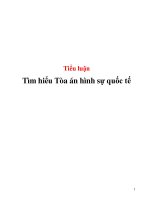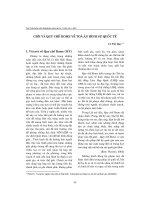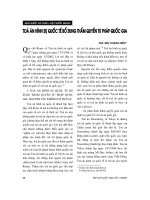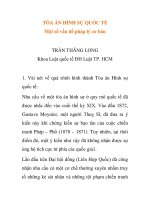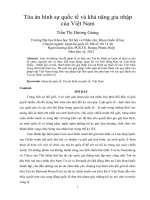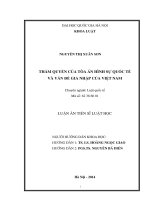- Trang chủ >>
- Cao đẳng - Đại học >>
- Luật
tòa án hình sự mỹ STATE COURT ORGANIZATION
Bạn đang xem bản rút gọn của tài liệu. Xem và tải ngay bản đầy đủ của tài liệu tại đây (28.99 KB, 4 trang )
U.S
All courts in the u.s. have in the courts, federal courts, French Court House
U.S. COURTS
The U.s. courts is the smallest unit of the federal justice system. Although some
cases are appeals appeal to Court of appeal or even the Supreme Court, but most
federal lawsuits are only to be tried in the Court of first instance. If in terms of
absolute numbers of cases to be heard, the courts are the workhorse of the Federal
judiciary. But the importance of it not merely as the service trial.
The first County Court in the Judiciary Act of 1789, the National Assembly has
decided to establish a network of Federal Magistrates. Section 2 of this Act has
established 13 courts, which regulates each of the 11 States at the time of the
Union is a seed, part of Massachusetts and Virginia later became Maine and
Kentucky each place is a seed. The mechanism of this organization has established
customs still maintain to this day, it was to divide the courts by State boundaries.
The current organization of courts
Today, all the counties have more than one judge; The southern counties of New
York, which includes Manhattan and the Bronx, we have 28 judges, and is seeded
with the judge. Because each trial of the federal courts are usually headed by a
judge, should control at a time can have more incidents to be tried at the same time
within a single seed.
Courts as courts of first instance
The Congress has built courts as the first instance trial Agency of the Federal
judicial system, and given the preliminary jurisdiction to them in almost all cases.
The Court is the only Federal Court that lawyers are working and confront between
those who testify. Therefore, the recording conditions are made at this stage. The
process of appeal is only focused on fixes rather than rebuild the saga.
Duty to determine the details of the jury, composed of a group of citizens of the
community, as do the unbiased arbitration of, and application of the law for details.
The Constitution protects the right of the jury in criminal cases according to the
constitutional amendment Friday, and in the civil service under the constitutional
amendment Wednesday. However, that right can be denied, and in that case, the
judge will be resolved by arbitration in both situations and the issues of law. This
case is called a judge at first instance (bench trial).
There are two types of jury comes with the federal courts. Grand jury is a group of
men and women gathered to determine whether there may be the basis to believe
that a person be prosecuted there for Federal offenders. The grand jury met
periodically to hear the accusations brought by the U.s. Attorney. In contrast, the
u.s. jury chosen at random in the community to hear the evidence and decide
whether the person being sued in a civil appeals may be subject to liability or not,
or a suspect in a case of first instance criminal guilty or not guilty. Federal Rules
required in criminal cases must have 12 jury. U.s. law regulating when ended a
case, the members of the jury are not allowed to talk to each other. When out of the
headquarters of the Court, they cannot be exchanged with people around, including
ones about the case and did not reach the Privy
STATE COURT ORGANIZATION
Magistrates with jurisdiction limited to criminal matters, the Court of the State
addressed three levels: micro (infractions), less serious crimes (misdemeanors) and
severe crimes (felonies). Magistrates with limited jurisdiction to only resolving less
serious crimes and infractions. It was only imposed penalty limitations (usually not
more than $ 1,000), and penalties of jail term is usually not more than one year
Trial with a public authority
Most States have a group trial to address the more serious criminal cases. Also, in
many States there are groups of special problems, such as juvenile criminal
offences in the jurisdiction of magistrates.
VIETNAM
Criminal Court in the people's Court of the Supreme People's Court and confirmed
by the provincial people's Court
The Criminal Court in the system of the appellate court of the Supreme People's
Court:
Extract of article 24
1. The Court of appeal of the Supreme People's Court has a Chief Justice Court, the
Associate Chief Justice to court, the judge, a court clerk.
2. The Court of appeal of the Supreme People's Court has the following powers
and duties:
a) appeal the case in which the judgment or decision at first instance has not yet
come into force the law of direct subordinate courts were appealed, the appeal
under the provisions of the law in the proceedings;
b) appeal against the decision of the provincial people's Court, the central cities of
declared bankrupt in accordance with law;
c) appeal against the decision of the provincial people's Court, the central cities of
the resolution of the strike under provisions of the law.
criminal court system who are dedicated to the provincial people's Court, the
central cities.
Article 30
1-The dedicated provincial people's Court, the central cities have stations, Deputy
Chief Justice of the Court, judge, court clerk.
2-the Criminal Court, Civil Court and the Administrative Court of the people's
Court in the central cities, have the following powers and duties:
a) at first instance the case under the provisions of the law in the proceedings;
b) appeals the case to which the judgment of the first instance decision, not the law
of the Court of appeal, were subordinate to protest under the rule of law in the
proceedings.
3-Economic Court in the people's Court, the central cities have the following
powers and duties:
a) first instance economic cases in accordance with the law in the proceedings;
b) appeals the case where the judgment of the first instance decision, not the law of
the Court of appeal, were subordinate to protest under the rule of law in the
proceedings;
c) solve the bankruptcy as defined by law.
4-The people's Labor Court, the central cities have the following powers and
duties:
a) at first instance the case to labor under the provisions of the law in the
proceedings;
b) appeals the case to the Labor Court, decision of first instance not valid law of
the lower court was appealed, the appeal under the provisions of the law in the
proceedings;
c) settle the strike as prescribed by law.

